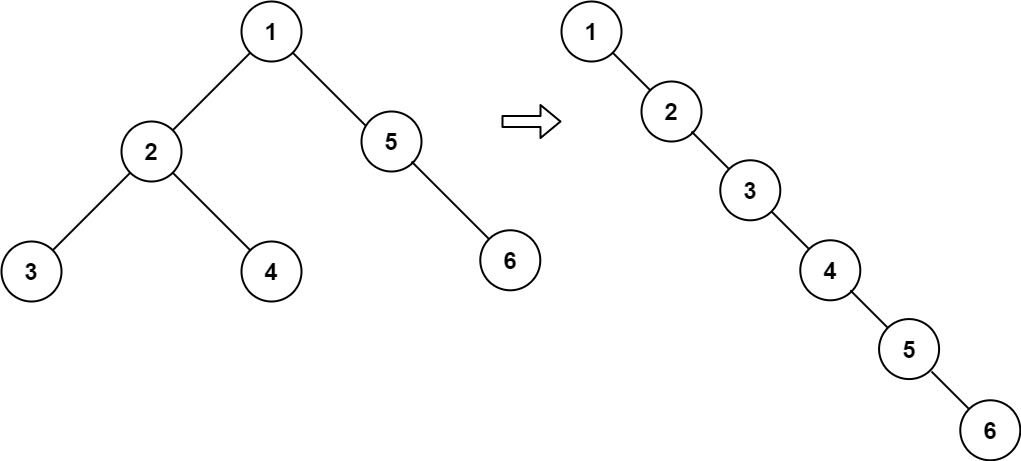Given the root of a binary tree, flatten the tree into a "linked list":
- The "linked list" should use the same
TreeNodeclass where therightchild pointer points to the next node in the list and theleftchild pointer is alwaysnull. - The "linked list" should be in the same order as a pre-order traversal of the binary tree.
Example 1:
Input: root = [1,2,5,3,4,null,6] Output: [1,null,2,null,3,null,4,null,5,null,6]
Example 2:
Input: root = [] Output: []
Example 3:
Input: root = [0] Output: [0]
Constraints:
- The number of nodes in the tree is in the range
[0, 2000]. -100 <= Node.val <= 100
Follow up: Can you flatten the tree in-place (with
O(1) extra space)?
# Definition for a binary tree node.
# class TreeNode:
# def __init__(self, val=0, left=None, right=None):
# self.val = val
# self.left = left
# self.right = right
class Solution:
def flatten(self, root: TreeNode) -> None:
"""
Do not return anything, modify root in-place instead.
"""
while root:
if root.left:
pre = root.left
while pre.right:
pre = pre.right
pre.right = root.right
root.right = root.left
root.left = None
root = root.right/**
* Definition for a binary tree node.
* public class TreeNode {
* int val;
* TreeNode left;
* TreeNode right;
* TreeNode() {}
* TreeNode(int val) { this.val = val; }
* TreeNode(int val, TreeNode left, TreeNode right) {
* this.val = val;
* this.left = left;
* this.right = right;
* }
* }
*/
class Solution {
public void flatten(TreeNode root) {
while (root != null) {
if (root.left != null) {
TreeNode pre = root.left;
while (pre.right != null) {
pre = pre.right;
}
pre.right = root.right;
root.right = root.left;
root.left = null;
}
root = root.right;
}
}
}/**
* Definition for a binary tree node.
* class TreeNode {
* val: number
* left: TreeNode | null
* right: TreeNode | null
* constructor(val?: number, left?: TreeNode | null, right?: TreeNode | null) {
* this.val = (val===undefined ? 0 : val)
* this.left = (left===undefined ? null : left)
* this.right = (right===undefined ? null : right)
* }
* }
*/
/**
Do not return anything, modify root in-place instead.
*/
function flatten(root: TreeNode | null): void {
while (root != null) {
if (root.left != null) {
let pre = root.left;
while (pre.right != null) {
pre = pre.right;
}
pre.right = root.right;
root.right = root.left;
root.left = null;
}
root = root.right;
}
};/**
* Definition for a binary tree node.
* struct TreeNode {
* int val;
* TreeNode *left;
* TreeNode *right;
* TreeNode() : val(0), left(nullptr), right(nullptr) {}
* TreeNode(int x) : val(x), left(nullptr), right(nullptr) {}
* TreeNode(int x, TreeNode *left, TreeNode *right) : val(x), left(left), right(right) {}
* };
*/
class Solution {
public:
void flatten(TreeNode* root) {
while (root) {
if (root->left) {
TreeNode *pre = root->left;
while (pre->right) {
pre = pre->right;
}
pre->right = root->right;
root->right = root->left;
root->left = nullptr;
}
root = root->right;
}
}
};
